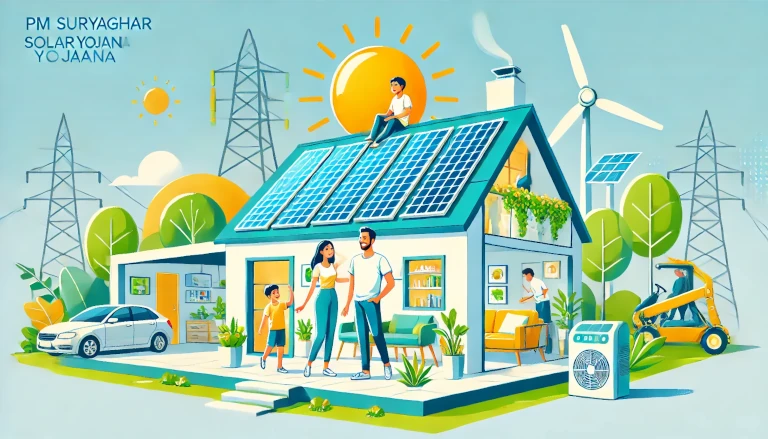Agrivoltaics, also known as agrovoltaics, is an innovative approach to land use that combines agricultural production with solar power generation. This system involves installing solar panels above agricultural fields, allowing crops to grow underneath while simultaneously generating solar energy. This dual-use approach benefits both the energy and agricultural sectors, creating a sustainable solution that optimizes land use, conserves water, and boosts crop resilience.
What is Agrivoltaics? 🌞🌾
Agrivoltaics is a method that integrates solar photovoltaic (PV) systems with agricultural activities on the same land. It involves mounting solar panels on elevated structures that provide enough space for crops to grow beneath. By harnessing sunlight both for solar energy and crop growth, agrivoltaics increases land efficiency and supports renewable energy goals while maintaining agricultural productivity.
Why is Agrivoltaics Important? 🌍
As the global demand for both energy and food increases, agrivoltaics addresses two significant challenges simultaneously: energy generation and food production. This system supports sustainable agriculture by:
- Increasing Land Use Efficiency: Maximizing the utility of land by producing solar energy and crops on the same area.
- Reducing Water Usage: Solar panels provide partial shade, reducing evaporation and conserving water for crops.
- Lowering Carbon Emissions: Generating renewable energy directly on farmlands reduces dependence on fossil fuels.
- Improving Crop Yield: In certain climates, the partial shade from solar panels can protect crops from extreme heat, enhancing crop growth and yield.
How Does Agrivoltaics Work? ⚙️
Agrivoltaics typically uses elevated solar panels, which are installed several feet above the ground, allowing sunlight to filter through and reach the plants below. The panels are often designed to track sunlight, adjusting their angles to optimize energy production while ensuring that crops receive adequate sunlight. This dual approach creates a microclimate underneath the panels, which can be beneficial for certain crops, helping to maintain soil moisture and reduce plant stress.
Where Can Agrivoltaics Be Implemented? 📍
Agrivoltaics is versatile and can be implemented in various regions and types of farmland, including:
- Arid Regions: Reduces evaporation, making it ideal for water-scarce areas.
- Fruit and Vegetable Farms: Works well with shade-tolerant crops like lettuce, tomatoes, and berries.
- Agro-Forestry Zones: Can support tree-based crops that thrive in partial shade.
- Remote or Off-Grid Areas: Provides an energy source for farms that are far from centralized power grids.
Agrivoltaics is especially beneficial in countries with high solar potential and growing energy needs, such as India, where agriculture plays a major role in the economy.
Benefits of Agrivoltaics 🌱⚡
- Enhanced Crop Growth 🌽
Solar panels provide partial shading, reducing heat stress on plants and creating a cooler microenvironment. This shade benefits certain crops, improving their growth and resilience. - Water Conservation 💧
With panels blocking some direct sunlight, water evaporation from soil is reduced, conserving moisture and requiring less irrigation. - Increased Land Productivity 📈
Agrivoltaics enables farmers to generate an additional income stream from solar energy without reducing arable land, effectively doubling land productivity. - Renewable Energy Production 🌞
Solar panels on farmlands contribute to renewable energy goals, reducing the carbon footprint of agriculture and supporting cleaner energy sources. - Economic Opportunities 💰
Farmers can benefit from both agricultural revenue and solar energy incentives, which provides financial security and diversification.
Financial Requirements and Cost of Agrivoltaics 💸
The cost of implementing agrivoltaics varies depending on the scale, equipment, and land type. The initial investment can be significant, covering expenses for elevated solar panels, mounting structures, and wiring. Generally, a small-scale agrivoltaic setup on one acre of land may cost between ₹10-₹15 lakhs in India, while larger installations could cost more.
Financially, agrivoltaics can be supported through government subsidies, grants, or low-interest loans, as many governments encourage renewable energy adoption. Payback periods range from 5-10 years, depending on energy yields, crop productivity, and available financial incentives.
Limitations and Challenges of Agrivoltaics ⚠️
- High Initial Costs 💰: The setup requires a significant investment in equipment and installation, which may not be feasible for small-scale farmers.
- Technical Expertise Required 🛠️: Agrivoltaics systems require skilled installation and maintenance, adding complexity to farm operations.
- Crop Selection Limitations 🌿: Not all crops are suited to agrivoltaics; shade-tolerant plants fare better, while sun-loving crops may be less productive.
- Maintenance of Solar Panels 🧹: Regular cleaning and upkeep of panels are necessary to prevent dust buildup, especially in arid regions.
- Potential Land Use Conflicts 🌍: Balancing agricultural activities and energy production can be challenging, particularly on small plots of land.
How Much Does Agrivoltaics Cost? 💲
- Small-Scale Setup: ₹10-₹15 lakhs per acre for basic infrastructure and solar panels.
- Large-Scale Setup: ₹25-₹40 lakhs or more, depending on the number of panels and required infrastructure.
- Government Subsidies: Many governments provide incentives for renewable energy installations, which can offset initial costs and make agrivoltaics more accessible.
Farmers and organizations interested in agrivoltaics may explore subsidies and financing options to make the transition more affordable.
Agrivoltaics for a Greener, Sustainable Future 🌱🌞
Agrivoltaics represents a forward-thinking approach to sustainable agriculture and renewable energy. By combining crop cultivation with solar energy production, agrivoltaics maximizes land use, conserves resources, and provides economic benefits for farmers. While there are challenges, such as high setup costs and crop compatibility, the long-term environmental and financial advantages make agrivoltaics an exciting solution for the future. As technology advances and financial support grows, agrivoltaics has the potential to transform agriculture and energy production worldwide.
Agrivoltaics harnesses the power of solar energy while supporting crop growth, making it a sustainable solution that increases land efficiency and promotes renewable energy.
Discover more from Green Ecosystem - Renewable Energy, Agriculture, and Environmental Sustainability
Subscribe to get the latest posts sent to your email.


